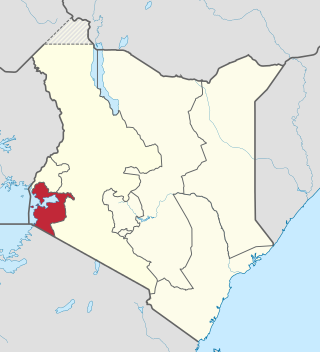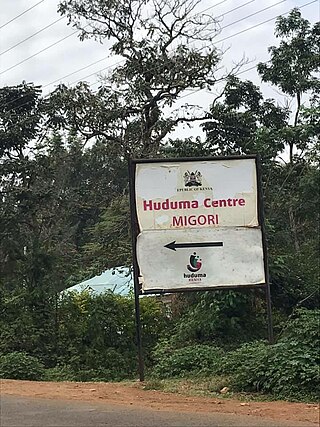The Nilotic peoples are people indigenous to the Nile Valley who speak Nilotic languages. They inhabit South Sudan, Sudan, Ethiopia, Uganda, Kenya, the Democratic Republic of the Congo, Rwanda, Burundi and Tanzania. Among these are the Burun-speaking peoples, Karo peoples, Luo peoples, Ateker peoples, Kalenjin peoples, Datooga, Dinka, Nuer, Atwot, Lotuko, and the Maa-speaking peoples.

The Luo, are several ethnically and linguistically related Nilo-Semitic ethnic groups that inhabit an area ranging from Egypt and Sudan to South Sudan and Ethiopia, through Northern Uganda and eastern Congo (DRC), into western Kenya, and the Mara Region of Tanzania. Their Luo languages belong to the western branch of the Nilotic language family.

The Abagusii are a highly diverse East African ethnic group and nation indigenous to Kisii and Nyamira counties of former Nyanza, as well as parts of Kericho and Bomet counties of the former Rift Valley province of Kenya. The Abagusii are unrelated to the Kisi people of Malawi and the Kissi people of West Africa, other than the three communities having similar sounding names.

The Suba (Abasuba) are a heterogeneous Bantu group of people in Kenya with an amalgamation of clans drawn from their main tribes Ganda people, Luhya people, and Soga who speak the Suba language that is closely similar to the Ganda language spare some lexical items borrowed from [[Luo. Their population is estimated at 157,787, with substantial fluent speakers. They migrated to Kenya from Uganda and settled on the two Lake Victoria islands of Rusinga and Mfangano, others also settled on the mainland areas including Gembe, Gwassi, Kaksingri of Suba South and Migori and are believed to be the last tribe to have settled in Kenya. The immigrants to present-day Subaland trace their ancestry among Ganda people, Luhya people, [[Busoga|Sogs, and the Luo people. The evidence supporting this is the fact that some Suba groups speak languages similar to Luganda, and the Luhya. The Suba groups tracing ancestry among the Kenyan tribes preceded those groups from Uganda in present-day Subaland and are the numerous and influential ones. Those groups from Uganda are mostly concentrated in Rusinga and Mfangano islands with small pockets of them being found in mainland Kenya. Linguistically, the Suba are highly influenced by the neighbouring Luo, to the point of a language shift having taken place among large portions of the mainland Suba. As a result, their own language has been classified as endangered. Despite this language shift, the Suba have kept a distinct ethnic identity. The Rusinga Festival is held in December of every year as a cultural festival to celebrate and preserve Suba culture and language.
Kisuba, also known as Olusuba, is a Bantu language spoken by the Suba people of Kenya. The language features an extensive noun-classification system using prefixes that address gender and number. Suba clans are located on the eastern shore and islands of Lake Victoria in Kenya and Tanzania. They have formed alliances with neighboring clans, such as the Luo people, via intermarriages, and as a result a majority of Suba people are bilingual in Dholuo. The Suba religion has an ancient polytheistic history that includes writings of diverse, ancestral spirits. A recent revival of the Suba language and its culture has influenced the increasing number of native speakers each year.

Nyanza Province was one of Kenya's eight administrative provinces before the formation of the 47 counties under the 2010 constitution. Six counties were organised in the area of the former province.

The Luo of Kenya and Tanzania are a Nilotic ethnic group native to western Kenya and the Mara Region of northern Tanzania in East Africa. The Luo are the fourth-largest ethnic group (10.65%) in Kenya, after the Kikuyu (17.13%), the Luhya (14.35%) and the Kalenjin (13.37%). The Tanzanian Luo population was estimated at 1.1 million in 2001 and 3.4 million in 2020. They are part of a larger group of related Luo peoples who inhabit an area ranging from South Sudan, southwestern Ethiopia, northern and eastern Uganda, Chad, Central African Republic, Nigeria, northeastern Congo-Kinshasa, southwestern Kenya and northern Tanzania.

Mfangano Island lies in the eastern part of Lake Victoria, at the mouth of the Winam Gulf. Part of Kenya, it lies west of Rusinga Island. The island is 65 km² in area and rises to 1,694 m at Mount Kwitutu. It had a population of 16,282 at the 1999 census. Administratively, Mfangano is part of Homa Bay County.

The Kuria people (also known as the AbaKurya, are a Bantu community in Tarime District of Mara Region in Tanzania and southern Kenya. Their homeland is bounded on the east by the Migori River and on the west by the Mara River estuary. Traditionally a pastoral and farming community, the Kuria grow maize, beans and cassava as food crops and coffee and maize as cash crops.

Migori also known as Suna-Migori is a multi-ethnic municipal town which acts as the capital of Migori County, Kenya. The town is located 63 kilometers south of Kisii town and 22 km north of the Tanzanian border. The Migori Metropolitan area consists of Migori municipality and the adjacent smaller towns. The area has three constituencies namely Suna East, Suna West and Uriri with a total population of 393,012 according to the Kenya National Bureau of Statistics sponsored national census of 2019. The neighboring town/constituency of Awendo has 96,872 and Kuria East (Sirare) has 117, 290. In 2010, The Star newspaper reported that the town (proper) had a population of approximately 100,000 people.
Kuria District was an administrative district in the Nyanza Province of Kenya. Its capital town is Kehancha. The district has a population of 256,086 and an area of 581/km2. It is inhabited by a minority group of people fondly known as Kuria people also referred to as Abakuria (Mkuria/Wakuria) in Swahili. They are scattered across the Kenya- Tanzania border and they are neighbors to the Kisii, Luo and Maasai people.
Shirati is a town in Rorya District in North Mara, Tanzania on the shore above Lake Victoria, near the border with Kenya. It has a population of c. 100,000 It is the northernmost town at the border with Kenya at is located in Royra District. Most of the residents of Shirati are DhoLuo speaking people Nilotes. Suba people, a subbranch of Bantu communities who adopted Luo customs, language, and practices also live in Shirati. Similarly, Shirati has a substantial number of Westerners who work at the mission at Kabwana – translated into "the white people's home" from Luo.

Migori County is a county in the former Nyanza Province of southwestern Kenya. It is located in Southwestern Kenya and borders Homa Bay County (North), Kisii County, Narok, Tanzania and Lake Victoria to the West. The county also borders Uganda via Migingo Island in Lake Victoria. The county is headquartered by Migori town, which is also its largest town. The Kenya National Census of 2019 indicated that Migori County had a population of 1,116,436 compared to 917, 170 in 2009 Census. Migori County is located in the sugar belt wetlands of Western Kenya and is mostly at the heart of the African tropics. However, the county enjoys a pleasant climate because of high altitude which modifies the climate alongside the cool breeze from Lake Victoria.

Rorya District is a district in Mara Region, United Republic of Tanzania. The district capital is the small town of Ingri Juu, while the largest town is Shirati. The district was created in 2007 from a part of Tarime District. It is bordered by Tarime District to the east, Butiama District to the south, Lake Victoria to the west, and the Republic of Kenya to the north. The majority of inhabitants are from the Luo tribe. Other ethnic group is Kurya. Kine, Simbiti,Sweta and Hacha are sub-groups within Kurya ethnic group.
Akelo's Village is a settlement in Kenya's Homa Bay County.
Lady Whitehouse is a settlement in Kenya's Nyanza Province.
Kuria is a Bantu language spoken by the Kuria people of Northern Tanzania, with some speakers also residing in Kenya.
Kenyan Australians are Australian citizens and residents of Kenyan origin and descent. They may be of indigenous African, European, or Indian heritage.
The Girango people is a group of Luo people who fall in the group known as Joka Jok. They include the Suna/Suba, Wategi/Kamagambo-Kanying'ombe, Wagire, JoKasgunga, JoSidho, JoKabar, JoMur, JoKiseru etc. They migrated to Kenya from northern Uganda, and are believed to be the brothers of the Simbiti. However, the Simbiti were absorbed into Kuria community, and that is why the people of Kuria have diverse origins. Some historians tend to use the Bunchari dialect of the Kuria spoken by the Simbiti, as well as the Kuria culture followed by the Simbiti to discuss the Girango people.









